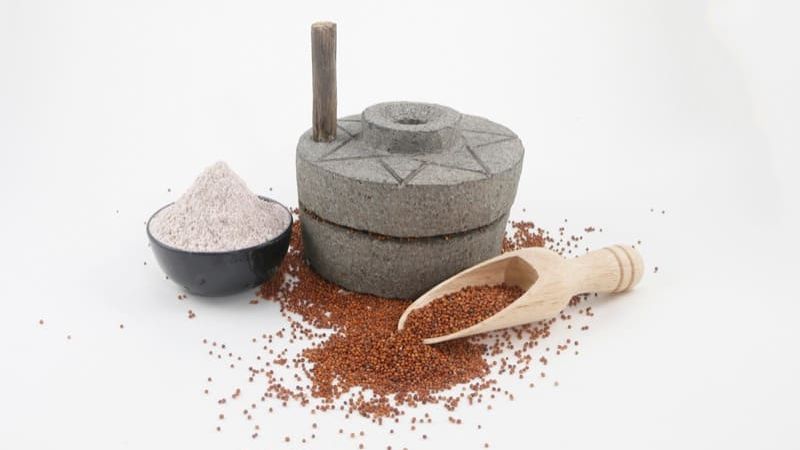

Our Review Process
Our articles undergo extensive medical review by board-certified practitioners to confirm that all factual inferences with respect to medical conditions, symptoms, treatments, and protocols are legitimate, canonical, and adhere to current guidelines and the latest discoveries. Read more.
Our Editorial Team
Shifa Fatima, MSc.
Author
Dr. Apoorva T, MHM.
MEDICAL ADVISOR
Benefits of Ragi For People With Diabetes
Individuals with Diabetes often lead dual lives; one in the world that everyone sees, and another; a parallel dimension where life is not easy, called the T2 Dia-verse. The Dia-verse is a scary place, and you may be tempted to seek solace and comfort with the notorious big-time baddie- Carbs!
But every time we get fooled and give in to temptation, we end up feeling worse than we did before. This is because when it comes to Carbohydrates, we overlook the fact that sugar is addictive, making it easier for us to consume it excessively. This is akin to paying a very high price, to stock up on a product we don’t need, only to end up stuck in a house filled with bulky packaging material that’s neither going anywhere nor easy to get rid of. Also know about is jaggery better than sugar?
But then where can a person with diabetes get their energy and nutrients from? How can one avoid bumping into these villains when they are present on every street corner? Is there a superhero who can combat these baddies and lead us to light from the dark depths of the dia-verse?
Presenting your saviour in the T2 Dia-verse, the Finger Millet, affectionately called Ragi by the locals.
Ragi is anti-microbial and has the ability to reduce bad cholesterol, induce weight loss, prevent cardiovascular diseases and bring diabetes under control. So let’s get right to it and take a look at this amazing ‘wonder grain’ with the potential to manage diabetes, cancer, osteoporosis and so much more. Know about is honey good for diabetes?.

What is Ragi Flour?
Ragi, or finger millet, is a staple food in many countries of Asia and Africa. Its tiny, spherical grain may be anywhere from almost white to nearly black. Porridge, flatbreads, and other traditional dishes are all made using ragi, a native grain. This food is a good source of calcium, iron, and fibre. This is why folks who suffer from wheat allergies or celiac disease often choose for this grain instead.
Ragi Nutrition Profile
| Ragi | Amount per 100g |
|---|---|
| Calories | 832 kcal |
| Total Fat | 4.3 g |
| Saturated fat | 0.5 g |
| Trans fat | 0 g |
| Cholesterol | 0 mg |
| Sodium | 4 mg |
| Total Carbohydrate | 75 g |
| Dietary Fiber | 3.5 g |
| Sugars | 1.7 g |
| Proteins | 11 g |
Effect on Blood Sugar Levels
- Ragi has a lower glycemic response than other grains which means its ability to increase blood sugar is very low.
- Compared to other grains, the high fibre content in Ragi prevents it from having major effects on blood sugar levels thus helping the blood sugar levels.
- Ragi contains micronutrients with high antioxidant levels called Polyphenols which helps to keep blood sugars in control.
- Ragi contains large amounts of magnesium which helps in increasing the efficacy of insulin.
- Magnesium also makes your body’s glucose receptors more effective.
Ragi Benefits
The biggest benefit of consuming Ragi is that its a Superfood !
The Table below showcases why Ragi is considered nutritionally superior to other Grains.
| Grain | Kcal | Protein | Fat | Fibre | Iron | Calcium |
|---|---|---|---|---|---|---|
| Rice | 362 | 6.8 | 2.7 | 0.2 | 0.7 | 10 |
| Wheat | 348 | 11.8 | 2.0 | 1.2 | 5.3 | 41 |
| Ragi | 336 | 7.3 | 1.5 | 3.6 | 3.9 | 344 |
Some of the other Benefits of including Ragi into your diet are -
- Incorporating ragi into your daily diet can help control blood sugar levels.
- Being a rich source of iron, it helps in increasing hemoglobin, hence helpful for anaemia
- The antioxidant properties of ragi helps in reducing the primary signs of ageing like wrinkles.
- Being gluten-free, Ragi helps in losing weight and is suitable for individuals with lactose and gluten intolerance.
- Prevents cardiovascular risks and improves heart health since it has zero cholesterol.
- High Calcium content helps prevent osteoporosis
- The best source of Proteins for individuals who are Vegetarians
Contraindications in Comorbidities
- Excessive intake of Ragi can increase the amount of Oxalic Acid in the body and hence not recommended for individuals with Kidney Stones or other Renal Complications.
- Ragi generally contains Goitrogenic Compounds that are bad for Hypothyroidism, so it is better to avoid food interference if you have a thyroid condition. Know about is honey good for diabetes?
Substitutes
- Oats and Jowar Grains can be consumed as good substitutes for Ragi.
- Unprocessed or Steel-cut Oats are a good substitute since they have a low glycemic index (53)
- White Jowar Grains have a low glycemic index (49.85) and are packed with antioxidants.
- Both Oats and Jowar contain 10% fibre which makes you feel fuller and for a longer period.
- Both Oats and Jowar are complex carbohydrates and get digested and absorbed slowly, hence not causing a rapid spike in blood sugar.
Five Minute Expert Ragi Recipes for Diabetics
Due to its low glycemic index, ragi is an excellent grain for diabetes. Several ragi dishes that are appropriate for diabetics are listed below.
Ragi Malt
Step-1 : Take a pan, put it on medium flame, add one cup of water and three tablespoons of ragi powder. Keep on stirring the mix to avoid any lumps.
Step-2 : Stir the mix until the mixture turns into a thick paste.
Step-3 : Add rock salt (as per taste) or jaggery (as per taste) to your liking.
Step-4 : Next, add some dried fruits of your choice and serve in a bowl and enjoy your bowlful of nutrition.
Expert Tip
- The best time to consume ragi is in the morning for breakfast; as it will help you stay energised all day long
- Double the benefits by adding in your favourite boiled vegetables to make them more wholesome.
Ragi Porridge
To make ragi porridge, combine ragi flour with water or milk and simmer for 5 to 7 minutes, or until it reaches the desired consistency. Season with salt, and use stevia or another sugar replacement for sweetness.
Ragi Idli
To make ragi idli, soak ragi flour in water for 6-8 hours and urad dal and rice in water for 12 hours. Combine all of the ingredients, including the salt, and steam them for 10-12 minutes in an idli machine.
Ragi Roti
Ragi Roti is a flatbread made with a dough consisting of ragi flour, grated vegetables (carrot, cabbage, onion), salt, and water. Roll the dough out thinly and cut it into tiny circles to fry on a hot griddle.
Ragi Dosa Recipe
Rice and urad dal must be soaked in water for at least 12 hours before being used to make Ragi Dosa. Ragi flour should be soaked separately for 6-8 hours. Mix all the ingredients in a blender until they form a homogeneous batter, then add the salt and let it sit for a while to ferment. Dosas should be prepared on a hot griddle in the same way as conventional dosas.
Ragi Upma
To make a savoury ragi upma, just toast the flour in a skillet. Chop some onions, tomatoes, and green chilies and sauté them separately. Cook the roasted ragi flour, water, and salt until the mixture thickens. In a hot dish.
Also Read: Best Whole Grains for Diabetics
Bottom Line
Ragi has been around since 1800 BC, and our history books speak quite eloquently about this wonder grain. Back in the day, the writers, poets and other literary greats were honoured with concoctions made of ragi, milk and honey. This was seen as a worthy way of felicitating someone of repute because of its beautiful rich reddish-black hue, pink when ground and purple when cooked. Although Ragi has stayed out of the spotlight for some years now, it has recently started receiving attention again for its potential role as a functional food. Whether used in age-old ways or more contemporary recipes and cuisines, make no mistake, Ragi is here to stay. Know about is honey good for diabetes?
FAQs
1. How much and in what form can Ragi be consumed every day?
Ragi can be consumed by grinding it into flour and used in a variety of ways. Since Ragi has a high glycemic index, the portion size should be regulated among those with diabetes. Make sure to consult a Diabetes Expert Nutritionist before including it in your daily diet.
2. Are there any Side Effects of eating Ragi?
Although Ragi has multiple benefits, over consumption may cause bloating, gas, diarrhoea, and constipation because of the high fibre content. It is also not helpful for people who want to gain weight or have kidney issues.
3. Is Ragi good for Weight Loss?
Adding Ragi into your diet is a good idea if you are looking to shed some kilos. It contains an amino acid known as Tryptophan, which helps in curbing appetite and boosting metabolism, thus facilitating weight loss. Ragi also has a good amount of fibre, which takes a lot of time to digest, hence keeps you satiated for a longer duration of time. Last but not the least, being low-fat. low calories in ragi and zero cholesterol, Ragi is the most ideal grain to go for if you want to lose weight.
4.Is Ragi Goitrogenic?
Indeed, ragi is goitrogenic because it contains compounds that may prevent the thyroid from properly absorbing iodine.
5.Does Ragi Cause Bloating?
Because of its high fibre content, ragi may aggravate bloating in those with sensitive stomachs or when ingested in big quantities. Some people may be able to take ragi just well, while others may have significant bloating. To minimise stomach upset, it is best to ease into a higher dose. Ragi's fibre content may be decreased and its digestibility improved by soaking or fermentation.

References
- https://www.newindianexpress.com/cities/chennai/2021/may/05/the-richness-of-ragi-2298459.html
Disclaimer
This website's content is provided only for educational reasons and is not meant to be a replacement for professional medical advice. Due to individual differences, the reader should contact their physician to decide whether the material is applicable to their case.








